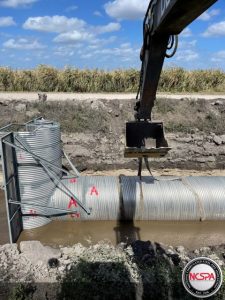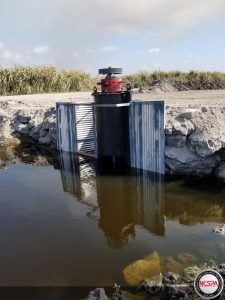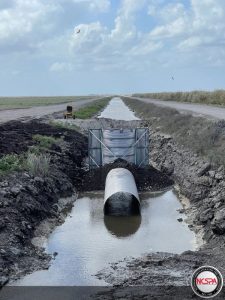By: Metal Culverts, Inc.

Florida agricultural producers have always relied on larger quantities of water for aid in the production of their various commodities. Producers rely on this water for irrigation, frost protection, and creating environments to grow certain crops in. South Florida was blessed with abundant water resources and they have created an expansive system of canals to help store this water and provide a means for producers to move water resources from one field to another.
In the past, producers would typically utilize large pumps and pump houses to aid in moving water through canals to where it was needed. These structures proved to be costly to construct and maintain. In a joint effort with a large sugarcane producer and a pum p dealer, Metal Culverts, Inc was able to help design a water control device that can operates manually using an adjustable water control gate but also provides as an diesel pumping option when needed. Using aluminized type 2 corrugated steel, Metal Culverts fabricated a 96” by 13’ tall half round riser structure that housed both a solid adjustable plate and a large submersible electric pump. Attached to the riser structure was a 50’ piece of 72” aluminized type 2 10 gauge CSP which acted as the outlet for the riser.

The corrugated steel riser system provided numerous benefits to the producer and land owner including noticeably lower material and installation costs, reduced operating costs, quicker installation with in house crews, and no costly and time consuming permits from local natural resource agencies. Costs for this structure and included pump were estimated to be approximately 1/3 of the cost to construct a permanent pump house. The project owner also realized substantial savings in installation and operation costs. Rather than bringing in numerous outside contractors to complete the project, the owner was able to use his own maintenance crew and his own equipment.

It is also important to note the project was able to be completed in 2 days! Construction of a permanent well house was estimated to take up to one to two months. Operationally, the project owners captured economic benefits by utilizing the water control gates and gravity vs paying to run a gas or electric pump system. And finally, installing this type of system did not require any special permitting with local water control authorities. Construction of a permanent pump house requires a fairly extensive and lengthy permit process to install as well as ongoing inspection/maintenance costs that the land owner is responsible for. Overall, this system has provided Florida ag producers an extremely economical and durable option when considering how they will be moving their water from field to field.